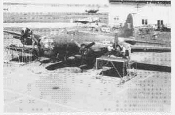While Japanese kamikaze aircraft were slashing the United States Fleet on the Pacific Ocean battleground, fighting admirals turned strategists in search for an antidote to the Oriental suicidal tactics.
Today at NAS Barber's Point, Oahu T.H. Airborne Early Warning Squadron One provides a vivid example of the results of the wartime search for a GI swami.
This eyes-and-ears squadrons ancestry goes back to the fall of 1945 when the first of its kind was commissioned. Single-engined scout aircraft were used, and then two-engined planes werre adapted to house the additional radar instruments.
Several months later the new outfit was incorporated into the Navy's Operational Development Force and designated VX-1.
During Atlantic Fleet exercises which followed, the real urgency of this type unit was visualized and the decision was made to locate one on each coast.
In 1948 Airborne Early Warning Squadron One made its West Coast debut at Ream Field, San Diego, California. Commander F. P. Anderson, who is currently the commanding officer of VW-1 was executive officer of its mainland predecessor.
When VPW-1 later moved to NAS Miramar, it was redesignated VP-51 and participated in fleet airborne early warning and anit-submarine warfare operations off the San Diego coast. They also engaged in air defense exercises on the entire West Doast and chased typhoons in the Pacific Ocean area.
 VW-1 CREW MAINTAIN RIGID CHECKS ON PB1W
VW-1 CREW MAINTAIN RIGID CHECKS ON PB1W
Then VP-51 played and important role in the atomic bomb tests at Eniwetok Island. A short time later the squadron was decommissioned because of budget difficulties.
However, owing to the value of an early warning unit, a detachment was maintained in the San Diego area at Miramar.
Constantly under evaluation, AEW operations proved a vital necessity to the security of the United States. Then on June 5, under command of LCdr. J. H. Copple, the Miramar detachment was deployed to the Hawaiian area and Barber's Point with PB-1W aircraft and squadron personnel. This type plane is the Navy reconnaisance version of the U.S. Airforce B-17.
From its post-war conception as the "Cadillac Project" until the commissioning of Airborne Early Warning Squadron One on June 18 1952, this comparatively new defensive theory has been subjected to a constant battery of tests and evaluations. Its rebirth as a full scale operating squadron indicates the acceptance of the new weapon.
